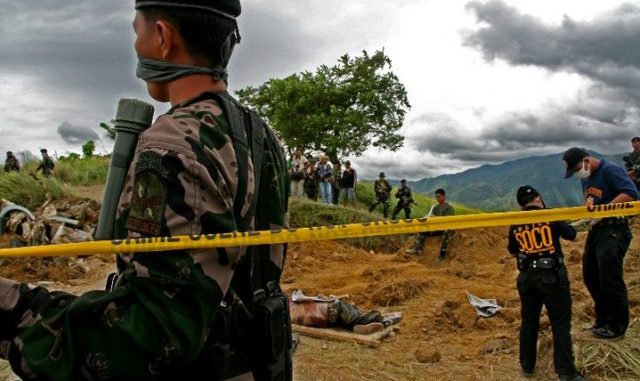by PASCAL LAUREYN
 A police commando stands guard as forensics investigators unearth the victims of the Ampatuan massacre. PHOTO/InterAksyon
A police commando stands guard as forensics investigators unearth the victims of the Ampatuan massacre. PHOTO/InterAksyon
It’s not just suspected drug users and dealers at risk of targeted killing in the Philippines. The International Federation of Journalists (IFJ) reported last week that the Philippines is the most dangerous country in Southeast Asia for journalists. Globally, the island nation came sixth on the list of most murderous countries.
Joaquin Brinoes, Rudy Alicaway, Leodoro Diaz and Crisenciano Ibon Lozada. These are new names to be added to a tragic roster of killed journalists. In August, a gunman shot columnist Crisenciano Ibon in the back and seriously wounded his driver. The police speculate the attack may have been in retaliation for his columns criticizing illegal gambling. He had received many death threats.
Broadcaster Rudy Alicaway and columnist Leodoro Diaz were attacked within two days time. They were both riding motorcycles when gunmen came up behind and shot them dead. Their murders are likely linked to their reports on political corruption, underground gambling and the drug trade. Journalist Joaquin Briones was killed the same way. He was known for his hard-hitting radio program.
There is a fifth killing, not included in the statistics of IFJ. In August, Michael Marasigan, a respected former newspaper editor, was shot dead in a Manila suburb. Rodrigo Duterte’s administration says it is doing all it can to apprehend those responsible. But so far, no arrests have been made.
President Duterte is a vocal critic of the press. Even before he took office, as president-elect, he sent a chilling message to the press corps: “Just because you’re a journalist, you’re not exempted from assassination if you are a son of a bitch,” he said at a press conference. “Free speech won’t save you, my dear.”
Need for independent reporting
The numbers of journalists being killed are dropping in recent years. But there is no room for complacency, says IFJ. Only a year ago, the Philippines was reported to be the second most dangerous country for journalists in the past 25 years. Only Iraq had more deaths. And in the Philippines, the IFJ warned, unprecedented numbers of journalists were jailed or forced to flee, self-censorship was widespread and impunity for the killings, harassment, attacks and threats against independent journalism was running at epidemic levels.
In September, Edito Mapayo, the editor-in-chief of Diaryo Balita, a local newspaper on the Mindanao island, was choked and punched by Surigao del Norte Vice Mayor Francisco Matugas Gonzales. And in August, a government official filed a libel case against ABS-CBN’s broadcast journalist Ted Failon and three members of his staff. They were looking into the “allegedly irregular purchase of secondhand motorcycles for Pope Francis’ visit to Manila in 2014”.
The country is in great need of independent journalists to report on human rights abuses, like the continuing war on drugs and the extended martial law in Mindanao. According to Human Rights Watch, the war on drugs has claimed 12,000 lives since president Rodrigo Duterte decided to purify his people from the evil of cheap drugs. Critics say he doesn’t let the law get in the way of his mission.
Last month, Congress approved Duterte’s request to extend martial law on the southern island of Mindanao until Dec. 31, 2018. UN special rapporteurs Victoria Tauli-Corpuz and Cecilia Jimenez-Damary released a statement on Jan. 3 saying that the Lumads, the non-Muslim indigenous people living on Mindanao, are suffering from the island’s ongoing militarisation.
“Thousands of Lumads have already been forcibly displaced by the conflict and have seen their houses and livelihoods destroyed,” the experts said in their statement. There were also reports indicating that military forces had killed local farmers in early December.
Toward Freedom for more
